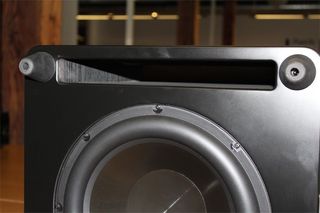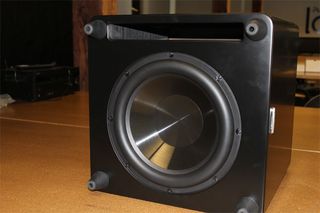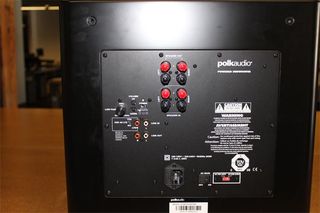The Polk Audio DSW 660 is a powerful and well-designed home subwoofer. Its unique features, including optional wireless connectivity and remote volume control, make it easy to change the settings to best suit your entertainment room. In addition, the sub’s 400-watt amplifier can fill rooms of any size with chest-thumping low frequencies. This combination of a design and power earn it our Top Ten Reviews Silver Award.

This subwoofer earned average scores in our listening tests. If you place it on its rubber feet, the speaker and port are both firing directly into the floor, which leads to some inaccuracies. During our movie listening tests, the DSW 660 struggled with sustained low-frequency effects. We figured it could be because the speaker was working in a confined area and pushing a tremendous amount of air back at itself, so we tried placing it on its side panel with the speaker and port front facing. This helped it perform better, but it still wasn’t at the level of the Yamaha SW300, which is the best-sounding subwoofer we tested.
The Polk DSW 660 has the narrowest frequency range of all the 12-inch subwoofers in our test group. A narrow frequency response doesn’t affect a subwoofer’s ability to create quality sound, but there is a good amount of low-end content, especially in movies, that resides just above that 125Hz range. All the other 12-inch subwoofers we tested can reinforce frequencies in that range, but this one does not.
Since it has an adjustable crossover, you can set the low-frequency starting point from 60Hz to 120Hz. If your AV receiver doesn’t have a crossover and LFE output, we suggest turning the crossover on the subwoofer to the maximum 120Hz setting and working back from there to match it to the room and your listening preference.

This subwoofer has the most powerful amplifier in our test group. Its 400-watt continuous power rating is impressive for a sub in its price range. All that power was apparent when we volume matched it with the speakers before we started testing.
Unlike all the other subwoofers we tested, the DSW 660 has volume buttons instead of a variable knob. This made it hard to tell exactly how much gain headroom was left after setting it up to project at 85 decibels.
The volume buttons are one of the sub’s few design flaws, and they could break if you toggle them often. Luckily, you can use the supplied infrared remote to control the volume output. This also makes it easy to adjust the volume up or down from your chair as you watch movies or listen to music.

This Polk model sets itself apart with its comprehensive feature set. The aforementioned infrared remote has controls for volume, mute, phase and power, along with four preset room modes that change settings to match the speaker placement. The room modes don’t need to be changed often, if ever, but the remote’s volume, mute and power controls mean you can place the woofer’s control panel close to a wall, since you don’t need to access it to adjust these settings.
This is one of two subwoofers in our test group that has a proprietary wireless connection. We tested the quality of wireless transmission with a third-party wireless subwoofer kit and found that there was a negligible difference between a wired and wireless connection. There was a slight drop in volume with the wireless connection, but this subwoofer’s 400-watt amplifier can more than make up for a 5-decibel volume loss. You should consider adding the proprietary wireless kit if you need to place your subwoofer in a spot that’s hard to run a cable to like behind your seating area or at the back of your entertainment room.
Polk includes a good warranty if you buy the DSW 660 from an authorized dealer. It covers the speaker against manufacturer defect and workmanship for five years, and the amplifier is protected for three years.
You can reach the manufacturer by phone or email if you have questions about the subwoofer’s features or how to integrate it into your current audio system. Polk’s website has a good FAQs page that has answers to general questions about setup and placement, but the knowledgeable support staff are a better resource if you have product-specific questions.
The Polk DSW 660 didn’t rank among the best subwoofers in our listening tests, but the difference between it and the best-sounding sub we tested is hard to notice, even when they are compared side by side. To get the best sound, we suggest placing this subwoofer on its side so the speaker and port are front-facing. This means the control panel will be on the side rather than the back panel, which doesn’t look as good and makes the buttons and knobs harder to access. Thanks to the handy remote, this shouldn’t be a problem.


